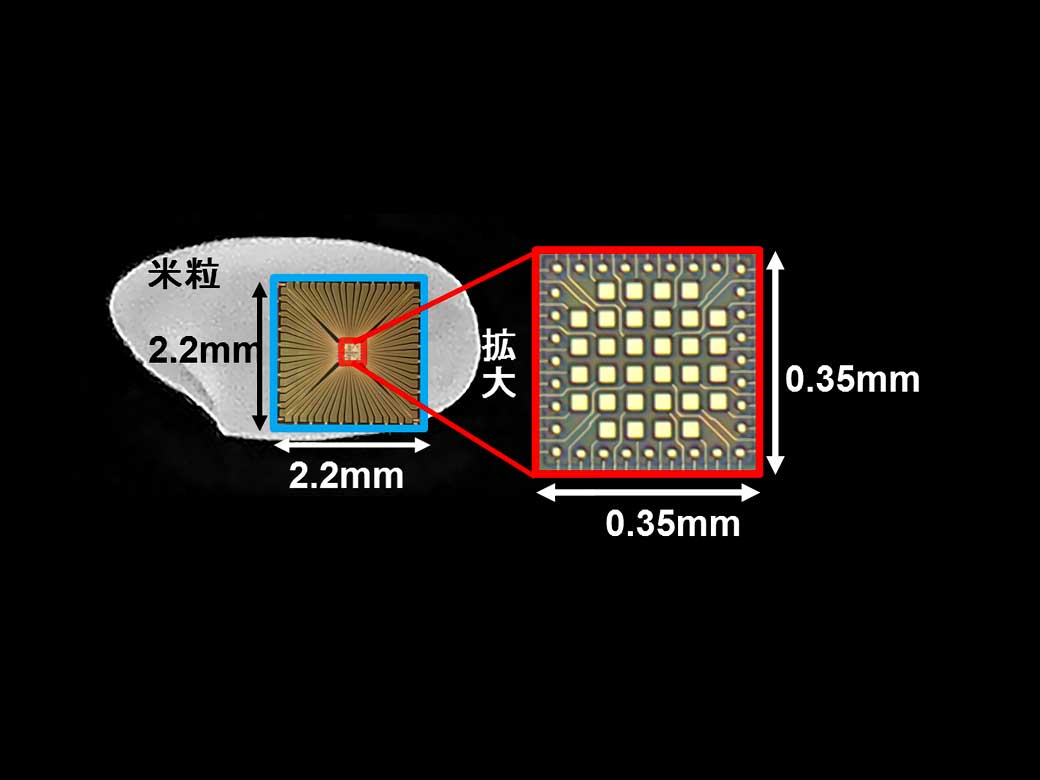High-speed integrated photo detector, smaller than a grain of rice
Wed, Sep 20, 2017-
Tags
First in the world to simultaneously receive and convert optical signals into electrical ones
To reduce size and electricity energy consumption of large-scale optical communication devices
 Internet traffic has dramatically increased, and in network mainlines and at data centers where massive data concentrate, minimizing installation space of optical fibers and communication devices as well as reducing their electricity energy consumption have become rising issues.
Internet traffic has dramatically increased, and in network mainlines and at data centers where massive data concentrate, minimizing installation space of optical fibers and communication devices as well as reducing their electricity energy consumption have become rising issues.
Waseda University Professor Tetsuya Kawanishi and the Network System Research Institute at the National Institute of Information and Communications Technology (NICT) collaborated to develop a multicore optical fiber, which has 7 to 36 cores per fiber. Furthermore, the multicore fiber has demonstrated a communication capacity of more than 100 times the conventional optical fiber by adopting multimode propagation.
However, optical signals from the optical fiber could only be received by separate optical receivers per core or mode, meaning that more physical space for the receivers was required as the number of cores increased. Hence, creating a more compact optical receiver that also reduced electricity energy consumption of the overall communication system became necessary.
This time, Professor Kawanishi and NICT developed together a high-speed integrated photo detector that simultaneously receives and converts optical signals into electrical signals. 32 light-receiving units are integrated into the photo detector, which is approximately 0.1mm2 in size, smaller than a grain of rice. It can receive optical signals from a number of channels all at once and convert them into high-speed electrical signals of over 10GHz per channel.
This photo detector integrates optical receivers and reduces size as well as electricity energy consumption of large-capacity optical communication devices at network mainlines and data centers, where massive data is processed with limited space and electricity. Moreover, the technologies employed in the photo detector could be applied in image sensors and laser rangefinders in the future.
Major achievements:
- Became the first in the world to develop a high-speed integrated photo detector of 0.1mm2, smaller than a grain of rice
- Worked towards a new optic fiber transmission system, which simultaneously receives and converts optical signals into electrical signals
- Reduced size and electricity energy consumption of large-capacity optical communication devices
Details on the high-speed integrated photo detector
Waseda University and NICT developed an integrated photo detector which is able to receive multi-channel optical signals all at once from multicore fibers of tomorrow, such as wavelength multiplex transmission in optical communication. Technologies employed for this device are the following:
- Crosstalk control for immunity against undesirable effects of signals
- High-speed photo detection which converts optical signals into electrical signals
- High density integration to manufacture semiconductors
- Quality evaluation
Waseda University designed the integrated photo detector using cross control technology. NICT was responsible for manufacturing the integrated photo detector with the high-speed photo detection and high-density integration technologies, as well as its quality evaluation. A part of the high-sped photo detector technology was developed for the Ministry of Internal Affairs and Communications to expand its radio wave resources.
The integrated photo detector reduces the number of optical receivers and space required for their installation, converting optical signals into electrical ones at once. Moreover, integrating the signal processing routes in each optical receiver into a single one vastly cuts electricity energy consumption. By directly connecting the integrated photo detector with multicore and multimode fibers and receiving optical signals this way will help realize a more compact receiver for optical fibers in the future.
Additionally, the integrated photo detector can measure the strength and phase difference of infrared light that emerges on two-dimensional surfaces, and this technology is expected to be used for image sensors and laser rangefinders in the future. The integrated photo detector is in parallel operation at 10GHz, 1,000 to 10,000 times faster in comparison to a CCD image sensor. Because the impact on operation is small even when increasing the integration, the integrated photo detector could be effective for imaging images with high frame rates.
Waseda University and NICT are now improving integration and quality and reducing the size of the integrated photo detector for practical use. In addition, the researchers are looking forward to applying this technology in fields outside of optical communication, such as image sensors and laser rangefinders for example. There will be a presentation on this research at the European Conference on Optical Communication (ECOC), one of the largest and most prestigious events in the world in this field, taking place in Sweden this September.













